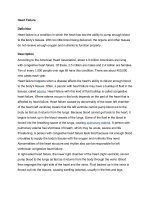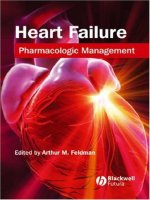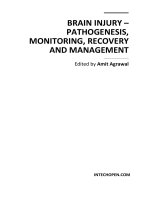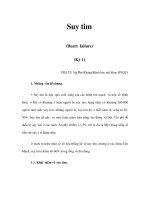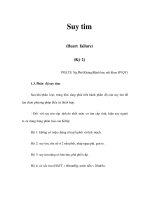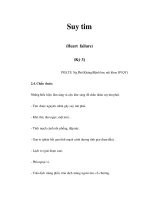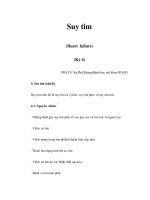Optimal Heart Failure Management potx
Bạn đang xem bản rút gọn của tài liệu. Xem và tải ngay bản đầy đủ của tài liệu tại đây (5.58 MB, 102 trang )
Optimal Heart Failure
Management
Daniel D Borgeson, MD, FACC, FASE
Assistant Professor of Medicine
Mayo Clinic College of Medicine
Mayo Clinic, Rochester, MN
Mayo Clinic
Rochester MN
November 4th, 2011
Disclosures: None
Heart Failure Management
LV Systolic
Dysfunction
Heart failure
With normal
Left Ventricular
Ejection Fraction
Tricuspid
Regurgitation
COPD
Sleep Apnea
Right Heart Faiure
Mitral Regurgitation
Cardio-Renal Syndrome
Coronary Artery Disease
Diabetes
Degenerative Joint Disease
Dementia
Atrial Fibrillation
Keep it simple
(as much as you can)
Are the Patients
Symptoms Due
to Volume Overload?
Are the Patients
Symptoms Due
to Low Output?
Is there a comorbid
condition that provoked
current condition?
Are there non cardiac
factors? Home issues,
Dietary compliance,
Dementia, OSA
Could this be an Atypical
Presentation of
Coronary artery
Disease?
Medical Management of
Heart Failure
Principles of Medical Management
• Only Three Types of Medications
• Medications that improve survival
• Medications that improve symptoms
• Medications you shouldn’t use
Principles of Medical Management
• Understand your Goals of therapy
• Is it volume removal?
• If so, diuresis is your answer
• Is it augmentation of cardiac output?
• Afterload reduction, digoxin, inotropes
• Is it control of a secondary issue that
resulted in the patient becoming
unstable?
• Heart rate control, medication
interaction etc
It’s the ART
of applying
the science
you know
Initial Evaluation
• Identify key factors which will lead to
individualization of therapy
• Acute vs chronic CHF
• Congestive vs low output symptoms
• Right heart symptoms vs left sided
symptoms
• Valvular heart disease
• Untreated ischemia
Individualization of Therapy
• Importance of Co-morbidities
• Atrial fibrillation (tachycardia)
• Hypertension
• Ongoing Ischemia
• Diabetes
• DJD (NSAID use)
• Renal failure
• Sleep apnea
ACE Inhibitor
Beta Blocker
Diuretic
Digoxin
Survival Benefit
YES
YES
YES
????
Symptom Benefit
YES
YES
YES
YES
Aldosterone Inhibitor
YES
No
CRT
LBBB
<65, Healthy
Tx, LVAD
Evolving Options
Remaining
Patients
Pharmacological
Therapy
Pearls
• Generally optimize volume first
• ACE traditionally next, then B Blocker
• Understand the mechanism of the CHF, if
possible treat the primary disorder
• Use medications that will optimize CHF
and the co-morbid diseases
• Remember, the right drug, at the right
dose, for the right reason
Heart Failure Management
Details
Medications that Demonstrated
Survival Benefit
• Genally thought to be a class effect,
first line therapy
• Improves survival
• Improves LV ejection fraction
• Improves symptoms
• Renal protective in diabetics
• Decrease MI in patients with CAD
0.1
0.2
0.3
0 1 2 3 4
Event rate
Years
Pfeffer et al: N Engl J Med 1992;327:669-77
SOLVD Trial: Congestive Heart Failure
Captopril
Placebo
Risk reduction=37%
P<0.001
What about Heart failure with Normal
Ejection Fraction
Perindopril in Elderly People with
Chronic Heart Failure (PEP-CHF
0
10
20
30
40
0 1 2 3
CP1265575-2
Cleland et al European Heart Journal 27:2238
Heart failure
Hospitalization
or death
(%)
424 374 184 70
426 356 186 69
Pt at risk (no.)
Years
Placebo
Perindopril
HR 0.92
95% CI 0.70-1.21
P=0.545
Perindopril In Elderly with
Chronic Heart Failure (PEP-CHF) Study
• Primary outcome of combined endpoint of all
cause mortality and unexplained CHF
hospitalization did not meet statistical
significance (3 years)
• Low event rate in placebo group
• Significant crossover to on label ACE-I
• At one year
• Improvement in 6 min walk duration
• NYHA classification
• Improvement noted at 1 year interval
Cleland et al European Heart Journal 27:2238
Angiotensin Receptor Blockers
Clinically appears to be a Class Effect,
some difference at tissue level
(much like ACE)
0
10
20
30
40
50
0.0 0.5 1.0 1.5 2.0 2.5 3.0 3.5
CHARM Alternative
Cardiovascular Death or CHF Hospitalization
Proportion with
CV death or
hospital
admission
for CHF (%)
CP1154535-27
Lancet 362, 2003
Years
Candesartan 1,013 929 831 434 122
Placebo 1,015 887 798 427 126
No. at risk
Hazard ratio 0.77
(95% CI 0.67-0.89), P=0.0004
Adj hazard ratio 0.70, P<0.0001
Placebo
Candesartan
CHARM Alternative: Observations
• Candesartan therapy resulted in risk
reduction in combined endpoint of
cardiovascular mortality or hospitalization
• Reduction of 7 major events per 100
patient years corresponding to the need to
treat 14 patients to prevent either CHF
Hospitalization or cardiovascular mortality
• Safe and effective alternative to ACE
Lancet 362, 2003
